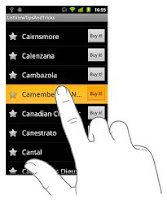In
addition to the beginning touch point and the last updated point, we
also keep track the currently displayed color and the full array of
colors that the view can rotate through. There are a number of things
we need to set up in the view’s subclass, the first of which is to
override the superclass’s -initWithFrame:method, After calling thesuper’s
initWithFrame,
build the color array for the view to rotate through and set the
initial colorIndex to
zero. Next, set the view’s backgroundColorbased on that index, and then
set the userInteractionEnabledto YESso that the application can
receive single touch events. With touchevents enabled, we need to
implement all the touchmethods to receive those
events. The first one is -touchesBegan:
withEvent.
This
method records the location of the beginning touch withtouchBeganPoint and
sets the lastUpdatedPoint to
the same location. We grab any of the touches from the set because we
are configured only for single touch events, so it is irrelevant as
to which touch we get. Now that the touch workflow is set, we need to
wait for the next event before we can perform any action. One of
three possible methods will be called, the easiest of which to
implement is the -touchesCancelled:withEvent.
A
cancel event occurs only when something interrupts the application.
For example, this might happen when there is an incoming SMS message,
phone call, or some other external event on the iPhone. As such,
don’t treat a cancel as a failure but as an opportunity to reset
the state. If the event is not canceled, you can send either of the
following two methods next: -touchesEnded:withEvent:or -touchesMoved:withEvent:.
For this application, we implement -touchesEnded:withEvent:
Using
this method, we first determine the delta of the current UITouchbased on the touchBeganPoint.
If the x ory delta
is greater than the tap threshold, the touch is treated as the end of
a move and resets the state. If the touch is within the tap
threshold, however, we need to change the background color of the
view and cause it to throb for visual feedback. After rotating the
color index and grabbing a reference for the next color, we begin an
animation block. This tells the iPhone OS that all the property
changes within this block should be performed together as a single
animation transaction. We then set ourselves as the delegate for the
animation. Because we want the transform to reverse, we need to add
another transform to the delegate call. This enables us to reset the
scale back to normal after the initial zoom as completed.
After
setting the delegate, we give it an @selectorto call back on when the
animation is complete. Finally, we apply the grow transform, set the
background color, and commit the animations. This now causes the view
to expand by 40 percent and change its background color in a smooth
animation. After this animation block is complete, we need to apply
another transform with the -throbReset:
context: method to undo the
grow transform.
Author
Bio:
Sussan Deyhim is a University Lecturer and Editor of Personal
Loan.
She loves to write on technical topics like SEO .
She is writing from last three years

